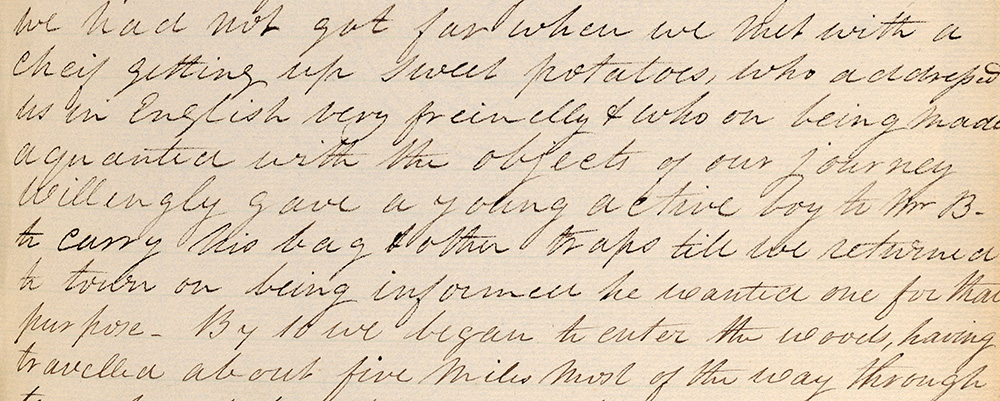Insights into our collections
RHS Plant Collector Archive: James McRae
James McRae (c.1792-1830) was the Horticultural Society’s sixth plant collector, having been dispatched to the Americas by the Society in 1824.
Who was James McRae?
James McRae (sometimes spelled MacRae) was a Scottish botanist. Little is known of his early life. Contemporary reports in the Botanical Register suggest that he was working as a gardener in the Botanic Garden on the Caribbean island of St Vincent in 1823. In 1824 the Horticultural Society recruited McRae to take a consignment of European plants and plants and seeds to Hawai’i, and to collect specimens from Hawai’i, Kiribati, the Galápagos Islands, Chile and Brazil. Upon his return to England in 1826, McRae was appointed Superintendent of the Botanical Gardens in Peradeniya, Sri Lanka, a post which he assumed in 1827. McCrae specialised in collecting orchids in Sri Lanka until his death in 1830.
Where did James McRae go to collect plants?
McRae travelled to Hawai’i on HMS Blonde, under the captaincy of Lord Byron, a cousin of the famous poet of the same name. Byron had been tasked with returning the bodies of the Hawai’ian King Kamehameha II and Queen Kamāmalu to their homeland, after both had succumbed to measles while visiting England in pursuit of audience with King George IV.

Robert Dampier, The H. M. S. Blonde, 1825. Source: Wikipedia. Public Domain.
McRae embarked on HMS Blonde at Woolwich, London, on 8 September 1824. The Blonde travelled via Brazil and around the Cape Horn, arriving in Valparaiso in Chile on 27 February 1825. From Valparaiso McCrae travelled to Hawai’i, where he arrived in May 1825. From Hawai’i McRae returned to Chile in October 1825, before heading back to England, via Saint Helena. McRae arrived back in England on 24 January 1826.

Map of James McRae’s expedition. The place names are those used by McRae in his account.
How did James McRae collect plant specimens?
McRae relied heavily on the assistance of local people in the places he visited. They acted as translators and guides, showed him the way to specific gardens, and provided labour, such as constructing boxes for plants, and carrying plant specimens. In some instances, it is highly likely that the unnamed people whose labour was “offered” or “sold” to McRae by fellow Europeans were enslaved, as several of the countries through which he travelled had yet to abolish slavery.
McRae was given permission to collect wild plants on Hawai’i by its King, but only after the funeral of the previous King and Queen had taken place, as the country was in mourning. As well as collecting plants, McRae observed and took notes on how plants including taro and tea tree were grown and used by local people. McRae’s contempt for and condescension towards many of the Indigenous people he met is clear from his writing. He makes numerous derogatory and dehumanising comments, particularly (but not solely) about the customs and appearance of Hawai’ian locals.
What plant specimens did McRae collect?
As well as collecting plants on his expedition, McRae also had the responsibility of transporting and keeping alive a great many plants on the long voyage to Hawai’i. Of the specimens he brought back, arguably the most notable was Araucaria araucana – better known to us as the monkey puzzle tree – the seeds of which he collected from Chile.
What is in the James McRae papers at the RHS Lindley Library?
The papers relating to McRae’s expedition to the Americas comprise a single volume. It consists of his journal, divided into five parts, along with the instructions given to him by the Horticultural Society, and other papers relating to his subsequent journey to Sri Lanka.
Aside from documenting his expedition, McRae also wrote an account of encountering the survivors of the shipwreck of the Francis Mary in the North Atlantic, on his voyage home. The story of the Francis Mary received widespread attention in the press at the time, with the six survivors recounting that they had resorted to eating the dead bodies of their fellow passengers to survive their ordeal. The papers also include McRae’s account of a mutiny on board the East India Company vessel Sarah, on which he travelled to Sri Lanka.
This Insight draws upon research carried out by Dr Sarah Easterby-Smith and Dr Elena Romero-Passerin (University of St Andrews) in 2021-2022, commissioned by the RHS.
Discover more
Published
5 May 2025
Insight type
Short read


![Chromolithographic plate depicting Araucaria araucana [monkey puzzle]](../../../pages/25/content/Araucaria_imbricata.jpg)